Native Son: The Awakening
1:55am. The coffee pot gurgles and belches. No coffee in there; instead, a batch of Yerba Mate slowly steeps to life. Yerba Mate is a tea made of the leaves from a South American holly, (Ilex paraguariensis). Hmmm…wonder if I can get it to grow in Texas…
2:04 am. Took me nine minutes to write three sentences. The cats are to blame; one wants out on the screened porch, the other wants attention. I finally chase Cocoa off…her idea of “a little attention” usually lasts about an hour.
Mid-February is a tough time to write about gardening. You’ve already exhausted all the typical winter subjects, and spring is sooooo close, but it’s not here. Sure, I’ve got a hyacinth here, a daffodil there, but there’s a lot of open real estate in between. Figure I’ll tell you about my trip to the back forty yesterday…whoops, Cocoa’s back. This could take a while.
2:20am. Cocoa’s happy.
As I enter the maze of little pocket prairies dotted between stands of red oak, elbow bush, and Chinese Privet (oh, don’t get me started on that indomitable plant’s invasiveness), I find myself floating back twenty years or so to a hike with Dr. Ken Steigman at the Heard Museum in McKinney. Ken taught me to see prairies with new eyes, and how to see the beauty in dormancy…the beauty that is simply invisible to most people.
Funny how people who sleep every sixteen hours demand that their garden never rest. Well, Mother Nature’s the gardener of prairies, and she lets her garden sleep. But to those with an eye for small details, nature never really dozes deeply on a Southern prairie.
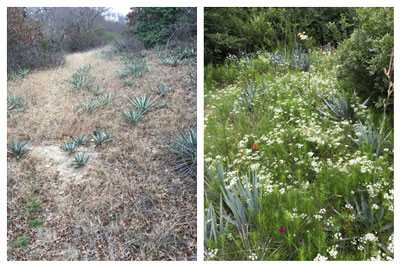
Above, left; the back forty prairie in winter and, at right, in late April.
The Elbow-bush (Foresteria pubescens) is in bloom along the fringes of the prairie. Its tiny greenish-yellow flowers look rather strange, like little fuzzballs stuck on gray stems. Earlier in the day, these petalless blossoms (the things that look like petals are technically open bud scales) were worked by bees and a few butterflies that still flit about in winter. The name, Elbow-bush, refers to the plant’s tendency to branch at 90-degree angles. Apparently, other people felt this was an uninspired moniker, so it’s also known as Spring-Herald, Herald-of-Spring, Devil’s Elbow, Stretch-Berry, and Chaparral.
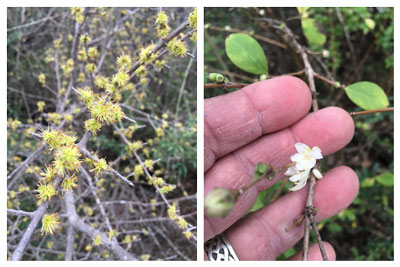
Above, left; Elbow-bush in flower and, at right, Winter Honeysuckle.
Next to it, I see the tiny, white, sweetly-fragranced flowers of Winter Honeysuckle (Lonicera fragrantissima). Native to China, it is not considered invasive, but there are about five specimens on the back forty prairie.
Nearby, a two-inch tall Standing Cypress (Ipomopsis rubra) is nestled within fallen leaves. It germinated from seed and grew to this size last fall. It rests as an evergreen during the winter, slowly developing the root system necessary to support the three to four-foot tall, unbranched stem it will grow in summer. That stem will be topped with a bloom spike almost two feet tall, loaded with red-orange flowers that not only attract a number of butterfly species, but also ruby-throated hummingbirds.
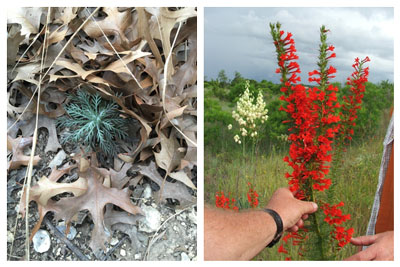
Above, left: Standing Cypress in winter and, at right, summer.
Pallid Yucca (Yucca pallida) is everywhere, dotting the sea of soft brown grasses with stars of pale green. Many of them will grow an amazing flower spike this spring. If not grazed off by deer, the spike will branch into a tidy arrangement of stems, adorned by ivory-colored, goblet-shaped blossoms that hang downward. Pollination of these flowers is usually performed at night, by moths.
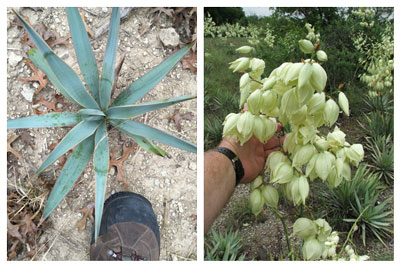
Above, left; Pallid Yucca mid-winter and, at right, in April bloom.
A bit of color near my boot attracts my attention. The winter foliage of a Stork’s-Bill (Erodium cicutarium) has turned orange and rust, but new, dark green leaves fill the center of the rosette. Native to the Mediterranean, it has spread across North America, a small but pesky invasive species.
I stick my finger into the frame for scale, but not until I look closely at the photo later to see the tiny world better. A leaf-hopper sits on the stem, some of the namesake stork’s bill fruit have already developed (which means it has already flowered), a tiny Four-Nerve Daisy, and some kind of Sedum, all growing upon a mat of what appears to be moss.
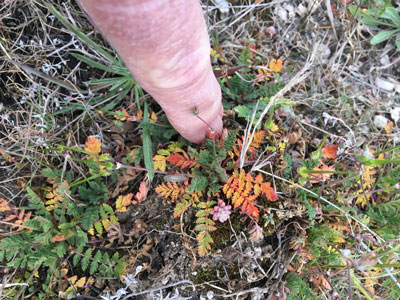
Above, a little microcosm of prairie in a few square inches.
There’s lots of beauty in this world, if we only have the open eyes and heart to see it. Something to think about, wherever you are.
I need a road trip! I’d love to come out and speak to your group. I’m low maintenance, flexible, and I’ll go just about anywhere…no city too big; no town too small. Just e-mail me at stevenchamblee@yahoo.com and we’ll work something out.
Come see me at Chandor Gardens! Call 817-613-1700 or go to www.chandorgardens.com for details.
